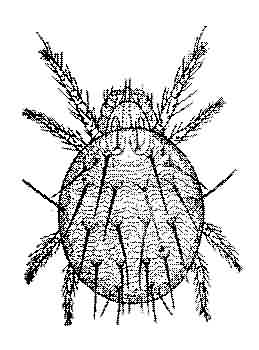Pests
Panonychus ulmi Koch - European Red Mite or Spider, Fruit Tree Red Spider
Systematic position.
Class Arachnida, order Acariformes, superfamily Tetranychoidea, family Tetranychidae, genus Panonychus Yokoyama.Synonyms.
Tetranychus ulmi Koch, Paratetranychus ulmi Koch, Metatetranychus ulmi Koch, Tetranychus pilosus Canestrini et Fanzago, Tetranychus mytilaspidis Ewing.Biological group.
It is a pest of apple, pears and plums mainly, and also of peach, cherry, cherry plum and almonds to a lesser degree.Morphology and biology.
The life cycle of mites includes stages of egg, larva, protonymph, deutonymph, and adult. Phases of dormancy and molting occur between the post-embryonic stages. Body of female oval, convex upward, and flattened ventrally, greenish- or reddish-brown. Propodosoma does not have frontal prominences. It has a piercing and suctorial type of mouthpart. Body length is 0.4 mm; body width is 0.26 mm. The body is light- or cherry-red, with black spots on each side. There are 26 long and thin setae rising from white tubercles in 7 transversal rows that are located on dorsal side of body. Body of male is weakly convex dorsally and ventrally, narrowed posteriad, brownish- or yellowish-green. Body length is 0.3 mm; body width is 0.15 mm. The 28 setae are located on dorsal side of body. Eggs orange-red or yellowish-orange, with radial sculpture on surface, rather flattened at poles, with small prominent stalk. Egg diameter is 0.15-0.16 mm. Larva rounded, later oval, yellowish-orange or greenish-brown, with 3 pairs of legs. Body length is 0.17 mm; body width is 0.11 mm. Protonymph and deutonymph broadly ovate, light- or brownish-red, with 4 pairs of legs. Body length of protonymph is 0.2 mm; its width is 0.14 mm. Body length of deutonymph is 0.27-0.34 mm; its width is 0.15-0.21 mm. Arrhenotoky type of parthenogenesis. Males appear approximately 1 day before females. Mating occurs only 1 time during the female life soon after its emergence, and oviposition begins in 2-4 days. Average fertility is about 19 eggs and the maximum is up to 70 eggs.Distribution.
The species is widely distributed throughout Northern America, Europe, Northern Africa, Middle East, Northern India and Japan. Damage has been reported in England, Portugal, France, Northern Italy, Switzerland, the Netherlands, Germany, Sweden, Finland, Poland, Hungary, and Bulgaria. In the southern hemisphere the species is known from Tasmania and New Zealand. In the former USSR it inhabits the Baltic States, Byelorussia, Moldova, the Ukraine, the European part of Russia, SE of West Siberia, Khabarovsk and Primorskii Territories, the Caucasus, Tajikistan and Uzbekistan.Ecology.
It is a mesophilous species, inherent to the zone of deciduous forests having precipitation of more than 500 mm per year. It is a polyphage; the major host plants belong to Rosaceae, but the pest also occurs on grapes, currant, buckthorn, white acacia, mulberry, linden, elm. Hibernates during the egg stage on the rough surface of bark on the underside of branches; on strongly infested plants the over-wintering eggs are sometimes laid in 2-3 layers. This species easily survives low temperatures. A period of 150 days with daily average temperature of 6°C and less is necessary for normal hibernation of eggs. Larva hatching coincides with the blossoming of plum and the blossoming buds of apple. It produces between 3-10 generations in the different parts of its distribution area. Temperature threshold of development for this species is about 8°C; degree days for development of one generation (without additional feeding of individuals) are 210°. Generation development with additional feeding lasts 28-33 days. Population density in nature depends on the activity of predators, e.g., Anthocoris nemorum L., Blepharidopterus angulatus Fall., Stethorus punctillum Ws., Chrysopa carnea Steph., Amblyseius subsolidus Begl., Paraseiulus incognitus Wain. et Arut.Economic significance.
Mites aggregate on the underside of leaves, pierce their epidermis with chelicerae, and suck cell plasma. Injured leaves become brownish and some fall. Infested trees decrease their annual growth and bud formation for the next year. Yield losses of apple reach up to 65%. Late-ripening apple varieties are more strongly injured. Inter-row plowing in gardens favors propagation of mites. Cultivation of resistant varieties of fruiters and whitewashing of tree trunks are important preventive control measures against the P. ulmi. Control measures include ovicide treatment in spring when the buds are hibernating, or acaricide treatment when buds blossom.Related references:
Bagdasaryan A.T. 1957. Fauna of the Armenian SSR. Tetranychid mites (Superfamily Tetranychoidea). Yerevan: AN Armenian SSR. 163 p. (In Russian)Batiashvili I.D. 1959. Pests of continental and subtropical fruit crops. Tbilisi: Institut sel'skogo khozyaistva. 455 p. (In Russian)
Bondarenko I.V. 1965. To the problem on Panonychus ulmi Koch geographical distribution. Proceeding of Leningrad SKHI. Plant protection against pests and diseases. Leningrad: Leningrad SKHI. V. 95: 84-89. (In Russian)
Livshits I.Z. 1967. Morphological and biological peculiaritis of Panonychus ulmi Koch, 1836 and Schizotetranychus pruni Oudemans, 1931. Pests and diseases of fruiters and plants. Proceedings of the Nikitskii Bot. Garden. Yalta: Nikitskii Bot. Garden. V. 39: 73-110. (In Russian)
Livshits I.Z., Mitrofanov V.I. 1973. A contribution to the fauna and biology of tetranychid mites of the Crimea (Acariformes, Tetranychoidea). Proceedings of the 3rd international congress of the Acarology. Prague: Academia. 229-235 p. (In English)
Livshits I.Z., Mitrofanov V.I. 1984. Order Acariformes. In: Kopaneva L.M., ed. Keys to harmful and useful insects and mites on the fruiters and berry crops in the USSR. Leningrad: Kolos. 288 p. (In Russian)
Mitrofanov V.I., Strunkova Z.I., Livshits I.Z. 1987. Keys to the tetranychid mites (Tetranychidae, Bryobiidae) fauna of the USSR and adjacent countries. Dushanbe: Donish. 224 p. (In Russian)
Prokof.ev M.A. 1987. Siberian orchards protection against pests. Moscow: Rossel.khozizdat. 239 p. (In Russian)
Reck G.F. 1959. Keys to tetranychid mites. Tbilisi: AN Georgian SSR. 151 p. (In Russian)
Reck G.F. 1976. Catalogue of Acariformes of the Georgian SSR. Tbilisi: Metsniereba. 128 p. (In Russian)
Savkovskii P.P. 1976. Atlas of pests of fruit and berry plants. Kiev: Urozhai. 207 p. (In Russian)
Vasil'ev V.P., ed. 1973. Pests of agricultural crops and forest plantations. V. 1. Kiev: Urozhai. 496 p. (In Russian)


